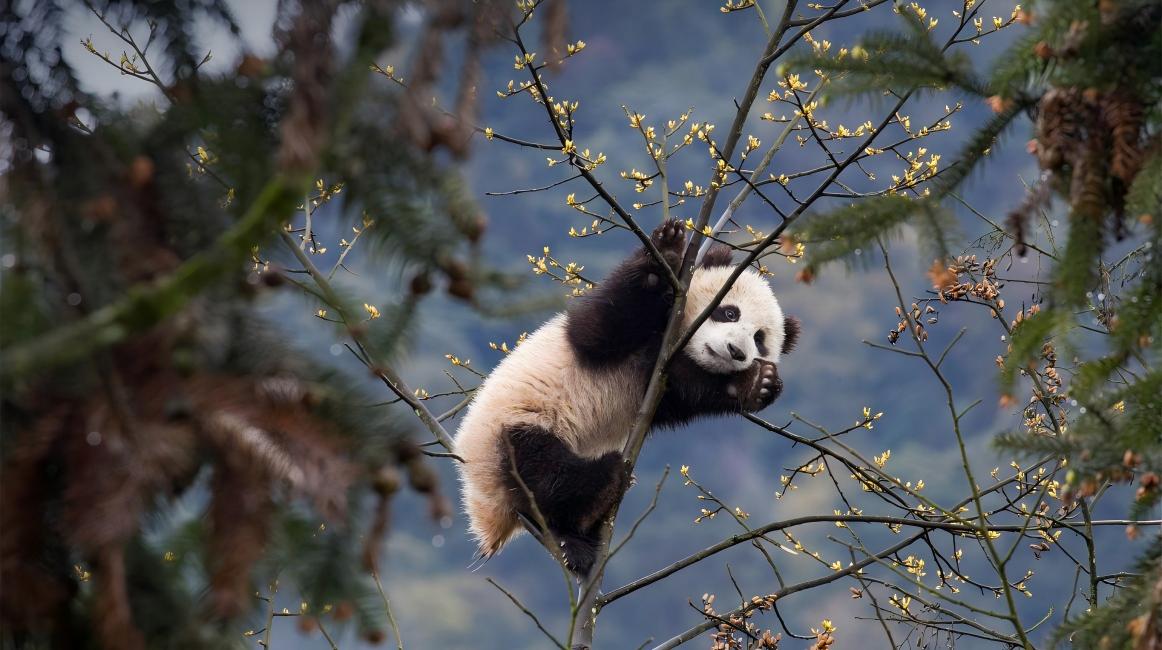In the southern foot of the Qinling Mountains and the depths of the Minshan Mountains in southwest China, resides a rare animal known as a "living fossil" — the giant panda. These cute creatures clad in black and white "armor" are not only China's national treasure but also a symbol of global biodiversity conservation, embodying the wonders of nature and the warmth of humanity.

A "Unique Existence" in the Biological World
The giant panda (scientific name: Ailuropoda melanoleuca) belongs to the Ursidae family of the Carnivora order, yet it has evolved a herbivorous diet centered on bamboo. It consumes 12 to 38 kilograms of bamboo daily, accounting for 99% of its feeding time. This unique feeding habit stems from adaptive evolution about 2.4 million years ago. Their molars are broad and sturdy, and although their digestive tract retains carnivorous characteristics, they compensate for the lack of nutrition in bamboo through rapid digestion and massive feeding.
Giant pandas are highly recognizable in appearance. Their black-and-white fur is a iconic feature — black fur concentrates around the eyes, ears, shoulders, and limbs, while white fur covers the trunk and head. This coloration may serve as camouflage in snowy environments or a signal for group identification. Adult giant pandas are approximately 1.2 to 1.8 meters long and weigh 80 to 120 kilograms. Despite appearing cumbersome, they are skilled at climbing trees, swimming, and can even run short distances at 20 kilometers per hour.

Ecological Home and Survival Wisdom
Wild giant pandas mainly inhabit the high mountain valleys of Sichuan, Shaanxi, and Gansu provinces in China. The mixed coniferous and broad-leaved forests at an altitude of 1,500 to 3,500 meters are their ideal habitat. Here, the climate is cool and humid, bamboo resources are abundant, and the complex terrain provides hidden habitats and breeding grounds for giant pandas.
Giant pandas are solitary animals. They mostly live alone except during the breeding season and divide their territories through scent marking (urine and perianal gland secretions). Their reproductive capacity is weak: female pandas go into estrus only once a year, with the estrus period lasting merely 2 to 3 days. After conception, the gestation period is about 95 to 160 days, and they usually give birth to 1 or 2 cubs per litter. However, in the wild, panda mothers can often only raise one cub to survival. Newborn cubs weigh only about 100 grams, are completely pink, and almost hairless. They need to be nurtured in their mother's arms for about 18 months before they can live independently.

A Conservation Miracle: From Endangered to Vulnerable
In the mid-20th century, due to habitat destruction, poaching, and other factors, the giant panda population sharply declined and was once on the brink of extinction. In 1963, China established the first batch of giant panda nature reserves. In 1988, giant pandas were listed as national first-class protected animals. Subsequently, ecological projects such as natural forest protection and grain-to-green were launched to gradually restore the giant panda's habitat.
Today, China has established 67 giant panda nature reserves, covering more than 70% of the wild giant panda's habitat. Through breakthroughs in artificial breeding technology, institutions such as the Chengdu Research Base of Giant Panda Breeding and the China Conservation and Research Center for Giant Pandas in Wolong have successfully achieved population expansion. As of 2023, the global captive giant panda population has reached over 600, and the wild giant panda population has recovered to 1,864. Their conservation status has been downgraded from "Endangered" to "Vulnerable", making them a model for global biodiversity conservation.

A Cross-Border Cultural Symbol
Giant pandas have a long history in Chinese culture. As early as the Western Zhou Dynasty more than 3,000 years ago, there were records of "mo" (the ancient name for pandas) in oracle bone inscriptions, and the ancients regarded them as auspicious creatures. Today, giant pandas are even more China's "national business card". Since 1957, China has presented more than 40 giant pandas to 14 countries through "Panda Diplomacy", serving as peace envoys to promote friendly relations between China and foreign countries.

From the emblem of the World Wide Fund for Nature (WWF) to the long queues outside zoos around the world, giant pandas have won the hearts of the global public with their gentle and lovely image. They are not only treasures of the biological world but also an emotional link connecting humans with nature, and China with the world, witnessing human awe and protection of nature.
The survival story of giant pandas is a miracle of natural evolution and a praise for human ecological protection. Today, these "bamboo forest hermits" still thrive in the high mountains and deep valleys, and human protection for them has never stopped. As an important member of Earth's biodiversity, the existence of giant pandas reminds us that only by living in harmony with nature can this precious gift be passed down forever.



